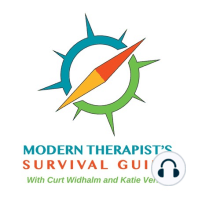33 min listen

Clinical Considerations When Working with Asian Immigrants, Refugees, and Dreamers: An Interview with Soo Jin Lee
FromThe Modern Therapist's Survival Guide with Curt Widhalm and Katie Vernoy
Clinical Considerations When Working with Asian Immigrants, Refugees, and Dreamers: An Interview with Soo Jin Lee
FromThe Modern Therapist's Survival Guide with Curt Widhalm and Katie Vernoy
ratings:
Length:
41 minutes
Released:
May 2, 2022
Format:
Podcast episode
Description
Clinical Considerations When Working with Asian Immigrants, Refugees, and Dreamers: An Interview with Soo Jin Lee Curt and Katie interview Soo Jin Lee, LMFT on the clinical implications of working with Asian American immigrants, refugees, and dreamers. We explore how best to assess these clients, specific clinical considerations related to the immigration experience (and legal status in the country), and ideas for working with these clients clinically. We also talk about the impact of societal views, media portrayals, and representation on AAPI clients. An Interview with Soo Jin Lee, LMFT Soo Jin Lee is a co-director of Yellow Chair Collective and co-founder of Entwine Community. She is a licensed marriage and family therapist in CA and has a special focus on training and consulting on Asian mental health related issues. She is passionate about assisting individuals find a sense of belonging and identity through reckoning of intersectional identity work and those that are navigating through difficult life changes. In this podcast episode, we talk about what therapists should know about Asian American immigrants, refugees, and dreamers In preparation for Asian American Pacific Islander Heritage month, we wanted to dig more deeply into specific issues relevant to the AAPI community that are often not discussed in grad school or therapist training programs. What assessment questions should be included for AAPI immigrant clients? How to assess and ask about the immigration story (including about whether someone is documented or undocumented) The assumption of citizenship status during the assessment Exploration of cultural values and family dynamics The definitions for refugee, asylum seekers, immigrant, undocumented immigrant, dreamer Looking at reasons behind coming to the United States as well as legal status in the country What is the impact of societal views and media portrayals of Asians on AAPI clients? The common stereotypes and the gap in the representation in the Asian diaspora The typical portrayal of undocumented immigrants from Latin America, Mexico, etc. Lack of representation in the media of the broad experience of being an undocumented immigrant or refugee The misrepresentation of families being all documented or undocumented (it’s actually a mix of statuses) Language, cultural and values differences between the generations What are the unique clinical issues for refugees and undocumented immigrants? “We call ourselves dreamers, but at the same time the dreams tend to be a lot smaller or not attainable because there are also educational barriers and there are financial barriers as well.” – Soo Jin Lee, LMFT The uncertainty of staying in the country The hidden traumas and the fear of being kicked out The lack of planning for the future Education and financial barriers to pursuing the future Trauma and PTSD are key elements, but sharing the story means that their survival is at risk How do therapists more effectively work with refugees and undocumented immigrants in therapy? “Provide a safe enough space and perhaps a more creative space, so that the story, the entirety of their journey, does not have to be nitpicked and talked about in a verbal manner. Are there modalities that you can adapt as a therapist, that they can go through in their mind, in a story book, in an art format, or any other way… that they can tell their story without being asked and interrogated about their story?” – Soo Jin Lee, LMFT The fear and risk involved in disclosure and the challenge of talking about identity Exploring their story creatively, without nitpicking or having to interrogate or make them verbalize their story The importance of building trust and building a safe space within therapy Bringing the mainstream media into the session Addressing fear and decision-making Soo Jin Lee’s healing journey to become a therapist and advice for other dreamers Our Generous Sponsors for this episode of the Modern Therapist’
Released:
May 2, 2022
Format:
Podcast episode
Titles in the series (100)
Therapist Know Thyself: A discussion about Self-Awareness and Self-Assessment, to Improve your Clinical Skills and your Career by The Modern Therapist's Survival Guide with Curt Widhalm and Katie Vernoy